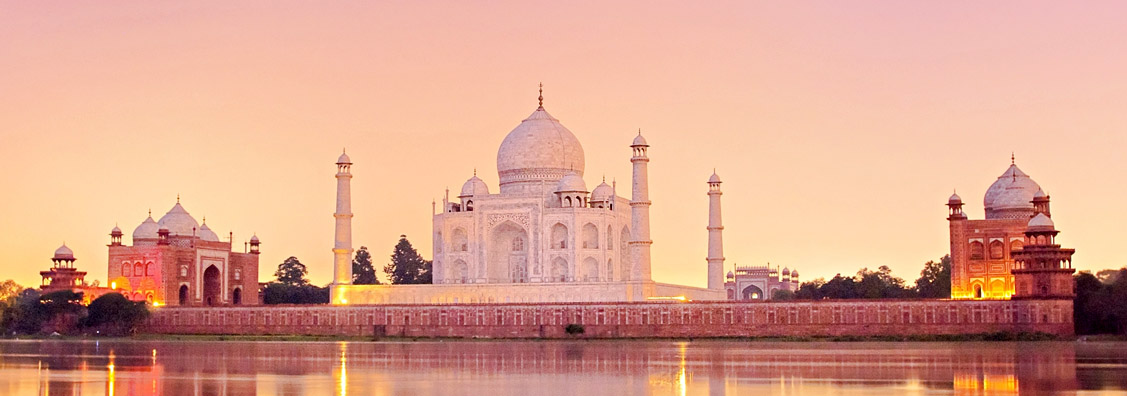

Home / Attractions / Agra
Agra is a city on the banks of the river Yamuna in the northern state of Uttar Pradesh, India. It is 378 kilometres (235 mi) west of the state capital, Lucknow, 206 kilometres (128 mi) south of the national capital New Delhi. Agra is one of the most populous cities in Uttar Pradesh, and the 24th most populous in India.
Agra's population is counted 1.8 million in year 2018, It is a major tourist destination because of its many Mughal-era buildings, most notably the Tāj Mahal, Agra Fort and Fatehpur Sikri, all of which are UNESCO World Heritage Sites. Agra is included on the Golden Triangle tourist circuit, along with Delhi and Jaipur; and the Uttar Pradesh Heritage Arc, tourist circuit of UP state, along Lucknow and Varanasi.
Agra is famous for its mouth watering delicacy 'Petha' a sweet made out of ash gourd with sugar syrup, and originated from the royal kitchen of Mughal. Angoori Petha, Kesar Petha and the original dry petha. Overnight Agra Tour is the famous for leather goods and is the one of the most provided leather goods city in Asia.
However, the 11th-century Persian poet Masud Sad Salman writes of a desperate assault on the fortress of Agra, then held by the Shahi King Jayapala, by Sultan Mahmud of Ghazni.] It was mentioned for the first time in 1080 AD when a Ghaznavide force captured it. Sultan Sikandar Lodi (1488–1517) was the first to move his capital from Delhi to Agra in 1506. He governed the country from here and Agra assumed the importance of the second capital.
The history of this beautiful city has monuments that hold memories dating back to centuries ago. In fact this city is as old as time can be. It dates back to the amazing mythical tales of Mahabharata. It was re –designed when the Mughal Rule took over in the 15th Century. The Mughal ruler called Sultan Sikander Lodi is the main founder of the world famous tourist attraction called Agra. This beautiful city was founded way back in the year 1504. Later on,Agra was the main capital of Mughals during their starting rule. Mughals ruled most of the territory of North India living in Agra and many monuments were built during their rule.
Agra continues to attract many tourists from around the world. People come all the way to sight the world famous Taj Mahal known for its symbol of love. Not to mention the formidable Agra Red Fort, Itimad-Ud-Daulah, Akbar Tomb (Sikandra) and Fatehpur Sikri are the interesting historical tales that each monument has to say.
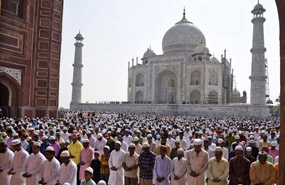
Taj Mahal meaning "Crown of the Palaces") is an ivory-white marble mausoleum on the south bank of the Yamuna river in the Indian city of Agra. The Taj Mahal Luxury Tour, it is an enormous mausoleum complex commissioned in 1632 by the Mughal emperor Shah Jahan (reigned from 1628 to 1658) to house the remains of his beloved wife, Mumtaj Mahal. Mughal Shah Jahan married Mumtaj aMahal in 1612 and cherished as the favorite of his three queens.
In 1631, Mumtaz Mahal died after giving birth to the couple's 14th child. The grieving Shah Jahan, known for commissioning a number of impressive structures throughout his reign, ordered the building of a magnificent mausoleum across the Yamuna River from his own royal palace at Agra.
Shah Jahan was a member of the Mughal dynasty that ruled most of northern India from the early 16th to the mid 18th-century. After the death of his father, King Jahangir, in 1627, Shah Jahan emerged the victor of a bitter power struggle with his brothers, and crowned himself emperor at Agra in 1628.
Taj Mahal also houses the tomb of Shah Jahan, the builder. The tomb is the centerpiece of a 17-hectare (42-acre) complex, which includes a mosque and a guest house, and is set in formal gardens bounded on three sides by a crenellated wall.
Construction of the mausoleum was essentially completed in 1643 but work continued on other phases of the project for another 10 years. The Taj Mahal complex is believed to have been completed in its entirety in 1653 at a cost estimated at the time to be around 32 million rupees. The construction project employed more than 20,000 artisans from India, Persia, Europe and the Ottoman Empire, along with some 1,000 elephants, were brought in to build the mausoleum complex under the guidance of a board of architects led by the court architect to the emperor, Ustad Ahmad Lahauri.
Its central dome reaches a height of 240 feet (73 meters) and is surrounded by four smaller domes; four slender towers, or minarets, stood at the corners. In accordance with the traditions of Islam, verses from the Quran were inscribed in calligraphy on the arched entrances to the mausoleum, in addition to numerous other sections of the complex. Inside the mausoleum, an octagonal marble chamber adorned with carvings and semi-precious stones housed the cenotaph, or false tomb, of Mumtaz Mahal. The real sarcophagus containing her actual remains lay below, at garden level.
The rest of the Taj Mahal complex included a main gateway of red sandstone and a square garden divided into quarters by long pools of water, as well as a red sandstone mosque and an identical building called a jawab (mirror) directly across from the mosque. Traditional Mughal building practice would allow no future alterations to be made to the complex.
Aurangzeb (Shah Jahan's third son with Mumtaz Mahal) deposed his ailing father in 1658 and took power himself. Shah Jahan lived out the last years of his life under house arrest in a tower of the Red Fort at Agra, with a view of the majestic resting place he had constructed for his wife; when he died in 1666, he was buried next to her.
The Taj Mahal was designated as a UNESCO World Heritage Site in 1983 for being "the jewel of Muslim art in India and one of the universally admired masterpieces of the world's heritage". It is regarded by many as the best example of Mughal architecture and a symbol of India's rich history. The Taj Mahal attracts 7–8 million visitors a year and in 2007, it was declared a winner of the New 7 Wonders of the World (2000–2007) initiative.
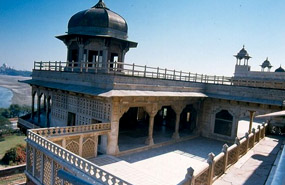
Agra Fort is a historical fort in the city of Agra in India. It was the main residence of the emperors of the Mughal Dynasty until 1638, when the capital was shifted from Agra to Delhi. Before capture by the British, the last Indian rulers to have occupied it were the Marathas. The Agra fort is a UNESCO World Heritage site. It is about 2.5 km northwest of its more famous sister monument, the Taj Mahal. The fort can be more accurately described as a walled city.
After the First Battle of Panipat in 1526, Babur stayed in the fort, in the palace of Ibrahim Lodi. He later built a baoli (step well) in it. His successor, Humayun, was crowned in the fort in 1530.
Realizing the importance of its central situation, Agra Fort was built in the year 1573 under the reign of Akbar – one of the greatest Mughal Emperors. It took more than 4000 workers and eight years of hardship to complete the fort. Knowing the significance of its location, Akbar built the fort to make it the main residence of the Mughals. The fort remained as the main residence of the emperors belonging to the Mughal dynasty until the year 1638. The fort houses numerous impressive structures like the Jahangir Mahal, Khas Mahal, Diwan-i-Khass, Diwan-i-Am, Machchhi Bhawan and Moti Masjid. In 1638, the capital of the Mughal dynasty was moved from Agra to Delhi, causing the Agra Fort to lose its status as the main residence of the Mughal emperors.
It was only during the reign of Akbar's grandson, Shah Jahan, that the site took on its current state. At the end of his life, Shah Jahan was deposed and restrained by his son, Aurangzeb, in the fort. It is rumoured that Shah Jahan died in Muasamman Burj, a tower with a marble balcony with a view of the Taj Mahal.
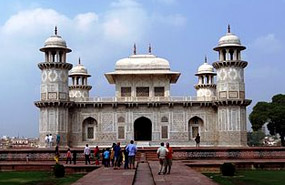
Tomb of Itimad-ud-Daulah is a Mughal mausoleum in the city of Agra in the Indian state of Uttar Pradesh. Often described as a "jewel box", sometimes called the "Baby Taj", the tomb of Itimad-ud-Daulah is often regarded as a draft of the Taj Mahal.
Along with the main building, the structure consists of numerous outbuildings and gardens. The tomb, built between 1622 and 1628 represents a transition between the first phase of monumental Mughal architecture – primarily built from red sandstone with marble decorations, as in Humayun's Tomb in Delhi and Akbar's tomb in Sikandra – to its second phase, based on white marble and pietra dura inlay, most elegantly realized in the Taj Mahal.
The mausoleum was commissioned by Nur Jahan, the wife of Jahangir, for her father Mirza Ghiyas Beg, originally a Persian Amir in exile, who had been given the title of Itimad-ud-Daulah (pillar of the state). It Located on the eastern bank of the Yamuna River, the mausoleum is set in a large cruciform garden crossed by water courses and walkways. The mausoleum itself covers about twenty-three meters square, and is built on a base about fifty meters square and about one meter high. On each corner are hexagonal towers, about thirteen meters tall.
The walls are made up from white marble from Rajasthan encrusted with semi-precious stone decorations – cornelian, jasper, lapis lazuli, onyx, and topaz formed into images of cypress trees and wine bottles, or more elaborate decorations like cut fruit or vases containing bouquets. Light penetrates to the interior through delicate jali screens of intricately carved white marble. The interior decoration is considered by many to have inspired that of the Taj Mahal, which was built by her stepson, Mughal emperor Shah Jahan.
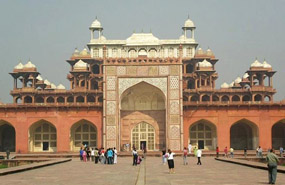
Akbar's tomb is the tomb of the Mughal emperor, Akbar and an important Mughal architectural masterpiece. It was built in 1604–1613 and is situated in 119 acres of grounds in Sikandra, a sub of Agra, Uttar Pradesh, India.
The tomb's construction was completed by his son prince Salim also called Jahangir. Akbar planned the tomb and selected a suitable site for it. After his death, Akbar's son Jahangir completed the construction in 1605–1613. During the Islamic ruler Aurangzeb's time, the rebellious Jats rose against him under the leadership of Raja Ram Jat, they took the control of Agra fort after defeating Mughal forces. Mughal prestige suffered a further blow when Jats ransacked Akbar's intricate tomb, plundered and looted all the beautiful gold, jewels, silver and carpets, whilst destroying other things. He even, in order to avenge his father Gokula's death, plundered Akbar's tomb, looted it, opened the grave, and dragged out the bones. Aurangzeb was so furious that he captured Raja ram and got him killed mercilessly.
It is located at Sikandra, in the suburbs of Agra, on the Mathura road (NH2), 8 km west-northwest of the city center. About 1 km away from the tomb, lies Mariam's Tomb, the tomb of Mariam-uz-Zamani, wife of the Mughal Emperor Akbar and the mother of Jahangir. The south gate is the largest, with four white marble chhatri-topped minarets which are similar to (and pre-date) those of the Taj Mahal, and is the normal point of entry to the tomb. The tomb itself is surrounded by a walled enclosure 105 m square. The tomb building is a four-tiered pyramid, surmounted by a marble pavilion containing the false tomb. The true tomb, as in other mausoleums, is in the basement. The buildings are constructed mainly from a deep red sandstone, enriched with features in white marble. Decorated inlaid panels of these materials and a black slate adorn the tomb and the main gatehouse. Panel designs are geometric, floral and calligraphic, and prefigure the more complex and subtle designs later incorporated in Itmad-ud-Daulah's Tomb.
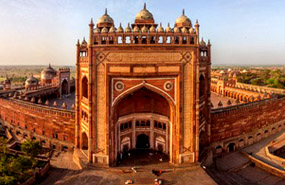
Fatehpur Sikri is a town in the Agra District of Uttar Pradesh, India. The city itself was founded as the capital of Mughal Empire in 1571 by Emperor Akbar, serving this role from 1571 to 1585, when Akbar abandoned it due to a campaign in Punjab and was later completely abandoned in 1610.
The name of the city derives from the village called Sikri which occupied the spot before. An Archaeological Survey of India (ASI) excavation from 1999-2000 indicated that there was a habitation, temples and commercial centres here before Akbar built his capital. It was also a much-loved place of Babur who called it Shukri for its lake of water needed for his armies. He used it for relaxation and also defeated Rana Sanga on its outskirts.
Akbar's son Jahangir was born at the village of Sikri in 1569 and that year Akbar began construction of a religious compound to commemorate the Sheikh who had predicted the birth. After Jahangir's second birthday, he began the construction of a walled city and imperial palace here. The city came to be known as Fatehpur Sikri, the "City of Victory", after Akbar's victorious Gujarat campaign in 1573.
This monumental complex embraces a palace, courtyards, gardens, gazebos, ceremonial gates, an artificial lake and the Jama Masjid, a mosque big enough for 10,000 worshipers. The buildings are made of the local red sandstone, and they reflect Akbar's expansive worldview, incorporating Persian, Hindu and Muslim elements in their design and decor. "There is hardly a more impressive city in all India,"
It was abandoned by Akbar in 1585 when he went to fight a campaign in Punjab. It was later completely abandoned by 1610. The reason for its abandonment is usually given as the failure of the water supply, though Akbar's loss of interest may also have been the reason since it was built solely on his whim. Ralph Fitch described it as such, "Agra and Fatehpur Sikri are two very great cities, either of them much greater than London, and very populous. Between Agra and Fatehpore are 12 miles (Kos) and all the way is a market of victuals and other things, as full as though a man were still in a town, and so many people as if a man were in a market.
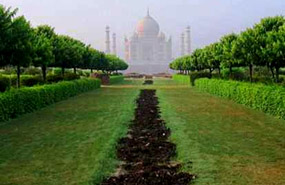
The park is located very close to Taj Mahal, across the river. It is located in Etmadpur region of Agra. A large pond inside the park reflects the image of Taj Mahal. You can find the foundation of the Black Taj Mahal near the pond.
On the northern side of the pond, you can find a step fountain now not in use. It is assumed that the fountain would have been used to feed the pond with water. Top plants to spot inside the park are Neem, Citrus fruits, Hibiscus, Jamun, Ashoka, Guava and others. You can find a lot of bright colored flower in the park.
Mehtab Bagh or the garden of the moon light was built between the years 1631 to 1635. The magnificent garden sprawling over an area of 25 acres is situated on the bank of river Yamuna. It is laid in symmetrical alignment with the Taj Mahal because its width is perfectly equal to that of the Taj Mahal. There is a large octagonal pool in the middle of the garden. It reflects the image of the Taj Mahal so that the visitors can enjoy the site of the great mausoleum while they are in the garden. The water in the pool was brought by a stepped waterfall. The garden unfortunately remained vulnerable to the floods in the river Yamuna since its inception in the Mughal era. The water has eroded its structure. It, therefore, lies in a ruined state. Out of the four sandstone towers that stood on its corners, only one has survived the marauding impact of the floods. The foundations of the two structures in the North and South of the pool that probably were garden pavilions are still visible
